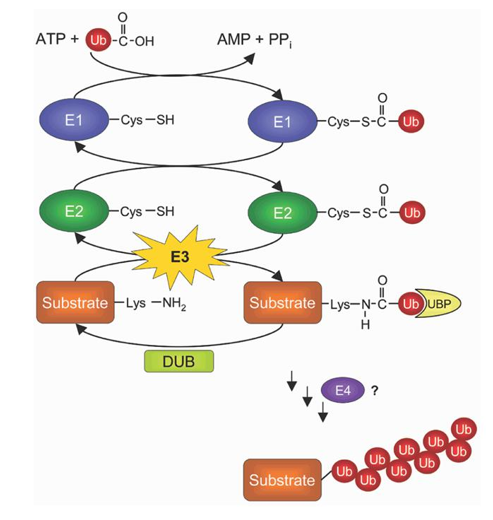The ubiquitin (Ub)-dependent pathway is a key regulatory mechanism which controls the degradation of proteins important in various biological processes such as cell cycle, DNA repair, transcriptional regulation, signal transduction, endocytosis and stress responses. It is therefore not surprising that deregulation of ubiquitin pathways has been implicated in the pathogenesis of many human disorders including neurodegeneration, inflammation and cancer.
Ubiquitylation is a covalent attachment of ubiquitin to the lysine residue(s) of a protein substrate which represents an important post-translational regulation of protein activity, half-life and localization. Ubiquitination of proteins requires a multi-enzyme system comprised of ubiquitin-activating enzyme (E1), ubiquitin-conjugating enzyme (E2), and ubiquitin ligase enzyme (E3). Ubiquitin is first activated by binding to E1 and then transferred to an E2 before covalently linked to a protein substrate in a reaction catalyzed by E3 ubiquitin ligase. Each E3 ubiquitin ligase recognizes a set of substrates and controls the specificity in ubiquitin-mediated protein degradation. Thus, targeting specific E3 ubiquitin ligases by using small molecules is a promising strategy to regulate the degradation of specific proteins.
 Figure 1. Mechanisms of ubiquitination.
Figure 1. Mechanisms of ubiquitination.
Creative Bioarray offers a wide range of cell-based ubiquitin drug target services, including deubiquitinating enzyme (DUB) profiling services, inducible degrader of LDLR (IDOL)-E3 ligase assays, custom HTS-compatible assays, and so on.
DUB Profiling Assays
- Selectivity and specificity of DUB substrates
- Potency of compound vs. existing DUB panel
- Test activation or interaction of your protein with known DUBs
E3 Ligase Assays
- E3 ligase expression & purification assays
- E3 ligase in vitro activity assays
- Binding affinities of E3 ligase inhibitors assay
- Substrate ubiquitylation assays
Features of the Ubiquitin Screening in Creative Bioarray
- Single concentration or IC50 determination
- Customizable panel - over 40 DUBs to choose from
- Fast rapid screening and profiling
- Get questions answered or project guidance in a time-efficient manner
With years of experience of the ubiquitin drug discovery, Creative Bioarray is dedicated to identifying your compounds interacting with target ubiquitin. We can significantly save your time and cost during your ubiquitin compounds screening. Moreover, based on prompt communication and on-time reporting, our scientists will ensure to meet your strict project timelines with high efficiency and quality.
References
- Passmore L. A. Barford D. Getting into position: the catalytic mechanisms of protein ubiquitylation. Biochemical Journal, 2004, 379(3): 513-525.
- Tian M. Y. et al.; A cell-based high-throughput screening method based on a ubiquitin-reference technique for identifying modulators of E3 ligases. Journal of Biological Chemistry, 2019, 294.
- Phosphatase Screening Services
- Phosphodiesterase Screening Services
- Poly (ADP-ribose) Polymerase (PARP) Screening Services
- GPCR Screening Services
- Kinase Screening Services
- Transporter Screening Services
- Ion Channel Screening Services
- HSP90 Screening Services
- Nuclear Receptor Screening Services
- Protease Screening Services
- High Throughput Screening Services
- High Content Screening Services
- Target-based Screening Services
- Phenotypic Screening Services
- Apoptosis Screening
- Epigenetics Screening Services